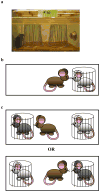Housing conditions and stimulus females: a robust social discrimination task for studying male rodent social recognition
- PMID: 19816420
- PMCID: PMC3018731
- DOI: 10.1038/nprot.2009.141
Housing conditions and stimulus females: a robust social discrimination task for studying male rodent social recognition
Abstract
Social recognition (SR) enables rodents to distinguish between familiar and novel conspecifics, largely through individual odor cues. SR tasks utilize the tendency for a male to sniff and interact with a novel individual more than a familiar individual. Many paradigms have been used to study the roles of the neuropeptides oxytocin and vasopressin in SR. However, inconsistencies in results have arisen within similar mouse strains, and across different paradigms and laboratories, making reliable testing of SR difficult. The current protocol details a novel approach that is replicable across investigators and in different strains of mice. We created a protocol that uses gonadally intact, singly housed females presented within corrals to group-housed males. Housing females singly before testing is particularly important for reliable discrimination. This methodology will be useful for studying short-term social memory in rodents, and may also be applicable for longer term studies.
Conflict of interest statement
COMPETING INTERESTS STATEMENT The authors declare that they have no competing financial interests.
Figures



References
-
- Ferguson JN, Young LJ, Insel TR. The neuroendocrine basis of social recognition. Front Neuroendocrinol. 2002;23:200–224. - PubMed
-
- Mateo JM. Development of individually distinct recognition cues. Dev Psychobiol. 2006;48:508–519. - PubMed
-
- Petrulis A, Alvarez P, Eichenbaum H. Neural correlates of social odor recognition and the representation of individual distinctive social odors within entorhinal cortex and ventral subiculum. Neuroscience. 2005;130:259–274. - PubMed
Publication types
MeSH terms
Grants and funding
LinkOut - more resources
Full Text Sources
Research Materials

